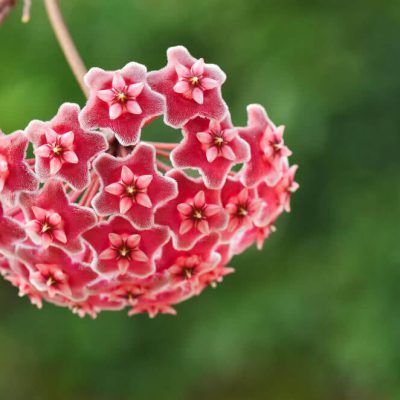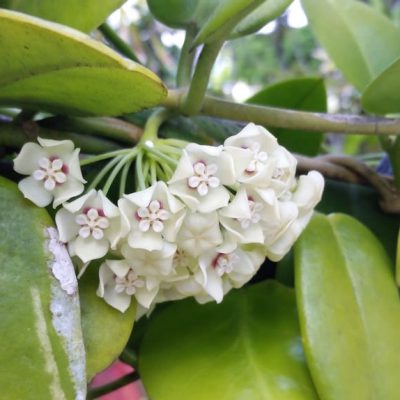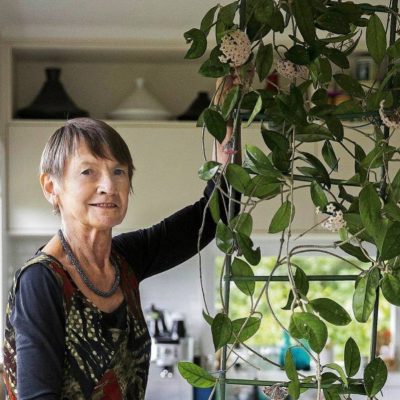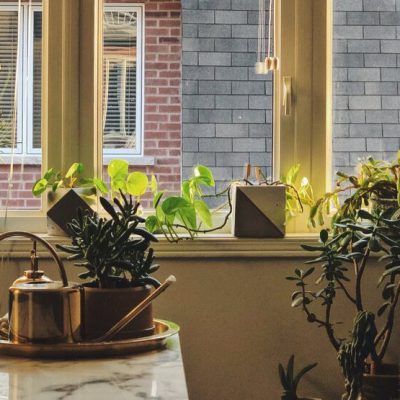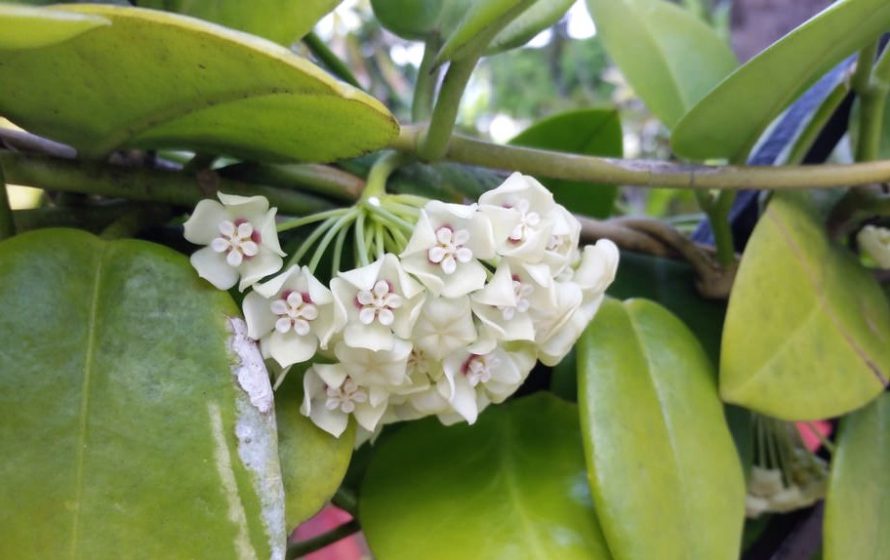
The Hoya Care Guide
Hoya plants are some of the easiest indoor houseplants to care for. They are slow-growing vining plants native to tropical and subtropical Asia. They are also known as Wax plants due to their thick and shiny foliage. As Hoyas mature, they produce clusters of sweet-smelling star-shaped flowers. Use these instructions to care for a Hoya. This guide will tell you how to water a Hoya; its light, temperature, humidity preferences and any additional care it might need to help it grow.
The Hoya Care Guide
Care Indoors
Light
A common mistake new growers make is putting them too near windows with direct sunlight, which can cause leaf burn. Most hoya (with exceptions) can’t withstand such direct, intense light. Since most species grow in the gaps of forests—among and between the treetops—they are more accustomed to getting dappled or diffuse light—and that should be recreated in the home.
When visiting different botanic gardens and growers of hoya, it is customary that they grow hoya under 50-80% shade cloth to protect from direct sun. I’ve found that more succulent varieties, like Hoya kerriii, Hoya crassicaulis, and Hoya diversifolia can withstand about 90% full sun conditions, but would still prefer a little less sun for fear that the intensity of the ultraviolet rays would break down the chlorophyll in the leaves. In some cases, certain varieties might begin to redden their leaves (e.g., Hoya vitellina), which can be pretty, but you have to be careful not to fully burn the plant and damage the chlorophyll in the process.
Most hoyas enjoy growing pulled away 1-4 feet (0.3-1.2 meters) from sunlight facing windows; near no-sunlight facing windows, augmented with grow lights; and completely under grow lights.
Potting
Most hoya don’t mind being a little rootbound, as they are used to growing epiphytically, so its not necessary to repot hoya often. Instead just refreshing their substrate every second or third year or so is fine. Because they like to dry out more than most plants, its preferable to use terracotta pots since they are porous and can more readily remove water from the soil substrate or potting medium—but do be sure to thoroughly water them so the entire soil ball becomes wet and is allowed to dry.
Soil / Substrate
Hoya, particularly the epiphytic ones, are accustomed to growing in very little substrate, so it’s not uncommon to find hoya mounted on wood and wrapped in Sphagnum for display in one’s home. Because of the lack of substrate in these displays, you’ll likely need to do more frequent watering. Spraying the roots every few days and treating them in much in the same way as air plants will help a lot.
Otherwise its easier to care for hoya in substrate. In Asia, it is customary to grow hoya in pure coco chips. Generally a good potting mix is about ⅓ peat, ⅓ perlite, and ⅓ orchid mix (fir bark, perlite, charcoal). This gives a fairly airy mix which is particularly important because hoya don’t like to be sitting in water. They require intermittent drying out. If they don’t dry out—they’ll rot pretty readily. But if they don’t receive enough water—their roots will often dry out and die back. (More on this in the Troubleshooting section).
Supplements
Some hoya species can be found in more limestone areas, so it would be intuitive for me to think that these hoya would grow well with a bit more alkaline (or “sweeter” soil).
Watering
Watering hoya thoroughly isn’t a problem if you have a well-draining soil mix. If your soil mix is too heavy—say a really peaty mixture—then you risk the substrate holding too much water. Try to water your hoya based on the quality and intensity of light that you are giving them. Those closer to sunlight facing windows should get a higher frequency of watering—and definitely more so in the summer months. Those that are growing near shaded windows or under grow lights will need watering far less. In some cases you should withhold water during certain times of year depending on the species. For instance, Hoya carnosa is accustomed to short periods of drought in its native habitat, so withholding water for 4-5 weeks in spring is customary and will help in flowering.
Temperature
Aside for the higher altitude species, which require slightly cooler temperatures in the evening hours—most hoya can’t withstand chilly temperatures. Anything below 50°F (10°C) can result in chill damage—so be wary if you’re ordering hoya over the winter months in the Northern Hemisphere; you’ll either need to purchase the appropriate amount of heat packs—or wait until spring delivery. The long time cultivated Hoya carnosa, however, is a bit more cold hardy and can even withstand icy drafts in the winter.
Humidity
Hoya are more accustomed to moderate to high humidity, particularly being from subtropical and tropical zones. Additionally, some go through a monsoon season, which means they are accustomed to heavy rains for part of the year. The more succulent hoyas are not necessarily too finicky if given less humidity—but most will thrive if given a bit more.
Some of the thinner-leaved varieties are nearly impossible to keep happy for any length of time if not given a level of 60-80% humidity, so position those around a humidifier or in some cases, within plastic bags (“the poor man’s humidifier”).
Fertilizer
Hoya aren’t particularly heavy feeders, however they appreciate some extra micronutrients and macronutrients. It’s a good idea to fertilize on a biweekly to monthly basis and with either a light, gentle, organic fertilizer or a balanced synthetic fertilizer cut by half. If you can see that one is about to flower, you may want to use a “bloom booster”, which is a bit higher in phosphorus. Whether this truly helps them to flower or not, is a matter of conjecture. There are some growers who use slow-release fertilizer, so that is an option as well.
Pruning
Hoya can grow large and unwieldy, so if you need to prune your hoya, then that is fine. Any dead, brown stems can be cut back. And if you have vigorous stems, you can either let them grow, wind them around a trellis, or just trim them back to a node. Note that when you are cutting the stems, the latex will often spew out. I do know some people who actually put glue on these “cuts” to prevent the latex from spilling out, but its not necessary. However, be sure not to cut the peduncle, which is the stem of the inflorescence. This is where the flower will emerge year over year.
Some species will naturally lose their peduncle, but it’s more common that hoya maintain their peduncle.
Propagation
As we mentioned in the beginning of the post, part of what make hoya so enjoyable as houseplants is that they are relatively easy to propagate. Most are amenable to just having one or two-node cuttings stuck in water, Sphagnum, or even a sterile potting medium. Thin, fuzzier varieties often are challenging to root. And if you have a woody stem, then they may also be more challenging to root—or may not root at all. Keeping up the humidity is often imperative to better rooting, so enclosing the plant in a plastic bag or humidity dome will help immensely.
Pests
Hoyas are fairly resistant to pests, but mealybugs can be found on leaves; and aphids can be commonly found near flowers, particularly hoyas that produce a lot of nectar, like Hoya kerrii, for instance. You can use sharp sprays of water to first get the pest down; and then I would recommend a horticultural oil or neem spray.
Troubleshooting Your Hoya
Below are some common signs that may be plaguing your plants:
Hoya leaves are burning / turning red — this may be a sign of too much sun, so move plant back from the sunlight or place in another area of the home.
Hoya leaves are shriveling — hoya may not be getting enough water and/or humidity, there may be die-back or an issue with the roots (perhaps they are dead or have dried up), or may be a sign of mealybugs. Check the plant and assess what the situation may be.
Hoya is starting to look limp — roots may have died back completely due to overwatering or lack of watering. Check the roots and if that’s the case, then take a healthy cutting to propagate the plant.
Hoya internodes are greatly extended — this likely means the hoya is in search of light and needs to be closer to a light source. You can move closer to a light source
Hoya hasn’t flowered — this can likely mean that the hoya has not had enough light, however, certain hoyas may require some type of “stress” to encourage blooms (i.e., cold period, dry period). This is usually determined by the type of hoya and what ecosystem/habitat it is from.
Buds fall off before bloom — this can mean that the potting medium was too dry for too long—or too wet for too long.
Buds fall off before bloom — this can mean that the potting medium was too dry for too long—or too wet for too long.
Leaves fall off abruptly — often means that the hoya got a cold draft or chill. Ensure the hoya is in a warm, humid location.
Hoya has sticky sap on the leaves — if the hoya is not in flower, then check if there are any sap-sucking insects, like aphids or mealybugs. This sticky substance may be an indication that there are pests on the plant and should be taken care of accordingly (see Pest section above). Some hoyas, like H. kerrii, H. multiflora, and H. imperalis, for example, can produce copious amounts of nectar. This can stain your furniture, cloth, and will coat leaves. Clean this off leaves, as it can invite aphids and sooty mold, for example.
One important thing to note: If you let your hoya dry out too long, try not to overload it with water on your next watering. Just give it a little water at a greater frequency.
